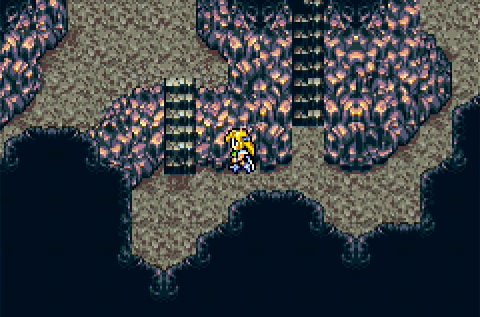
Locke and Celes’ path takes them from South Figaro back to Narshe. You know this route; you’ve already traveled it in the other direction. The prevailing theme of the game so far has been “retrace your footsteps,” and this sequence doesn’t disappoint. In this case, you need to pass through the cave between the desert and South Figaro.
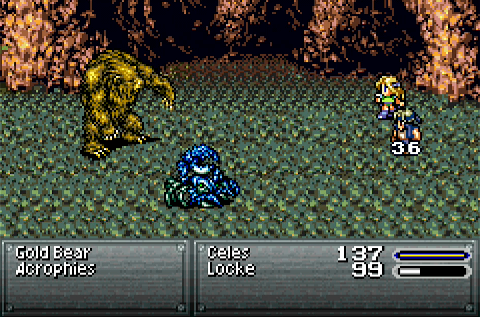
To keep it interesting, though, the designers have stocked the caves with enemies more appropriate to the current party’s (presumed) levels. These two could steamroll the hornets and other puny enemies from the previous trip, but the upgraded foes pose more of a threat. Why exactly the monsters here have been replaced by more dangerous creatures is never really stated — maybe there was some sort of ecological apocalypse while the team spent years locked in the Lete River experience loop? — but it makes this sequence into something more than just a perfunctory trip through known territory. It also provides attentive players with a cue: You’re on the right path, even if it seems like you’re just covering old ground, because here’s something you haven’t seen before.
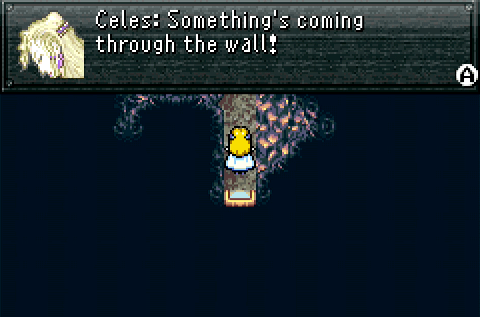
Throughout the trip through the cavern, the screen occasionally vibrates in sync with a strange rumbling sound. As you approach the exit, the source of this sound becomes clear: The Empire has attempted to stop you by sending a magic-slinging tunneling weapon after you.
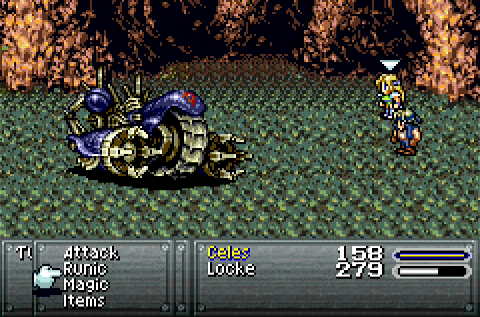
This is a nice little bit of setup; Final Fantasy games usually see you fighting a boss in dungeon scenarios like this, but unless the boss is specifically story-related, what you face off against usually just amounts to a random super-powerful creature that happens to reside along your path. In this case, the “random” boss isn’t quite so hard to explain, and it even comes with its own built-in foreshadowing.
The Tunnel Armor is by far the most powerful opponent to have appeared in the game so far save the Heavy Armors, which were optional. Unlike them, you have to pass Tunnel Armor to get to your next destination… and it comes at the end of a dungeon with no mid-point save opportunities, so the stakes for loss are higher than usual.
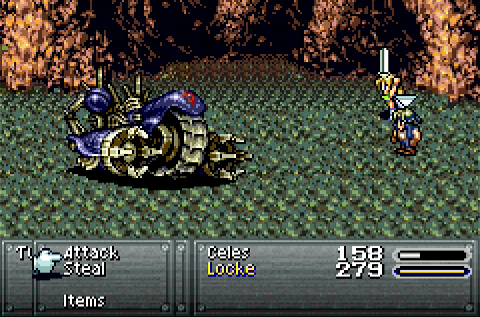
The Tunnel Armor battle poses a challenge in its own right, but it also serves as a tutorial battle for Celes’ mysterious Runic skill. As the fight begins, Celes tells Locke that she can shut down many of Tunnel Armor’s attacks with her Runic skill. While this ability served zero purpose in the passage beneath South Figaro, where no enemies used magic, here it has tremendous value — though Runic alone can’t win this fight.
Runic is an entirely passive skill, which is why it seemed so useless in South Figaro. Celes’ class is Runic Knight, and Runic basically works like a magical Cover skill. Rather than acting directly for a turn, Celes will instead use her spell blade as a sort of lightning rod…
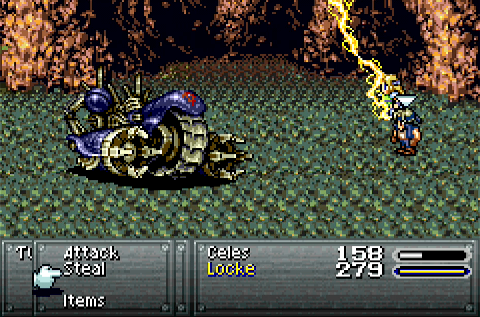
….literally, in this battle, wherein the Tunnel Armor frequently casts the Lightning spell.
While the Tunnel Armor’s magic attack power is sufficient to make this spell a one-hit KO to a single-targeted character and bad news if it splits the spell across both party members, with Runic active Celes is able to absorb the spell. It hits her sword and disperses, doing no damage.
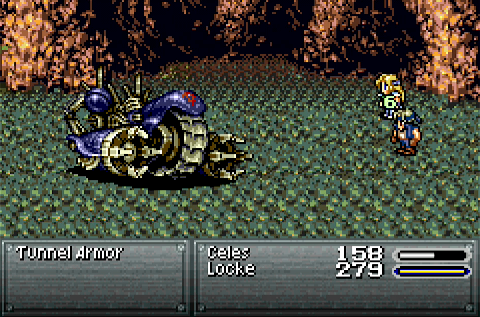
And, as a bonus, the absorbed spell restores to Celes the number of magic points the caster expended on the spell. She will continue to suck spells from the air for as long as she maintains the Runic stance, no matter how many spells are cast. Once her turn comes up again, she’ll lower her posture until you select Runic again. This means that Runic is a rare instance in which Slow status can be a boon: Because Celes remains in her Runic state until her ATB meter refills, if you slow down her charge time she’ll maintain her defensive posture longer.
However, Runic does have some downsides. It only works on “normal” magic — that is, spells the party can learn. Special magic-like attacks, which most enemies favor over straight spells, won’t be affected by Runic. Worse yet, Runic absorbs all spells during that turn, both the enemy’s and the party’s. Forget about casting Cure or Raise while Celes holds her sword high. Sure, you can use this factor in a pinch to restore some MP to Celes without using an Ether or a spell like Rasp, but it greatly limits her efficacy in the latter half of the game, when the entire party has access to all kinds of crazy magic spells and uses them on the regular. Still, Runic does have its uses, and in battles like this it proves invaluable.
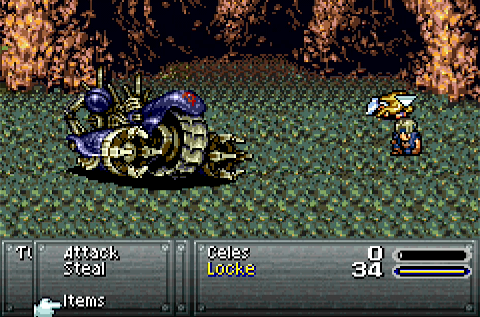
However, as I mentioned, Runic alone won’t win this fight. While Celes wields her Runic blade, all her other skills are unavailable, placing both attacking and healing duties on Locke’s shoulders. Tunnel Armor doesn’t strictly use magical attacks, so healing plays a role here; the machine has a Magitek Laser that bypasses Runic, and its physical Drill attack inflicts major damage to a single character. Thankfully, it has fairly low HP, so Locke can beat it down on his own despite his low attack power, but it can be a tough fight — especially if Celes’ Runic falls out of sync with the Tunnel Armor’s spell-casting and it manages to slip in one of those powerful spells during the brief interim between her turns.
This would also be a good time to mention the importance of the evasion stat, which didn’t work correctly in the original Super NES version of FFVI (FFIII) but saved my bacon in this battle on GBA. Locke managed to evade two consecutive attacks in his critical state, giving him enough time to revive Celes and heal up before launching a final salvo of winning attacks against Tunnel Armor. Some armor and Relics and most shields boost a character’s evasion stat; the importance of shields here makes their value far more apparent than in many RPGs, and turns tactics like duel-wielding or two-handed grips into a tradeoff between defense and offense.
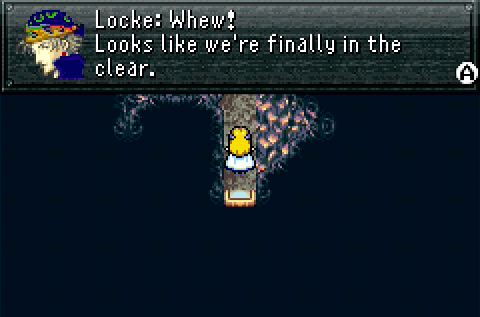
With the Tunnel Armor defeated, Locke’s scenario ends — you don’t actually need to travel to Narshe on your own power, because as much as this game likes for you to retrace your footsteps it has to draw the line somewhere.
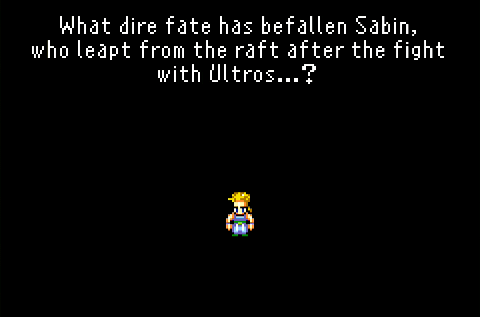
And for our purposes, that leaves just one final scenario to explore — by far the lengthiest and most involved sequence of the three, spanning far more ground than Terra and Locke’s scenarios combined and introducing two new permanent party members (plus a third semi-permanent member, and a weird guest as well).
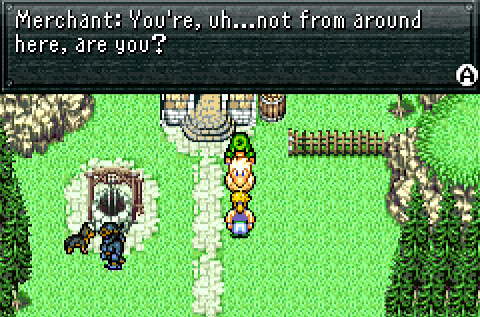
It begins, as so many Final Fantasy scenarios do, with Sabin gaining consciousness after having washed ashore. This isn’t an Ys game, so there’s no winsome local lass to find him. Instead, he simply pulls himself to his feet and heads out.
There’s a small house in the wilderness immediately to the side of Sabin’s landing point on the coast — an optional stop, but one you’d be foolish to pass up. There’s a merchant here, along with that guy from the pub in South Figaro.
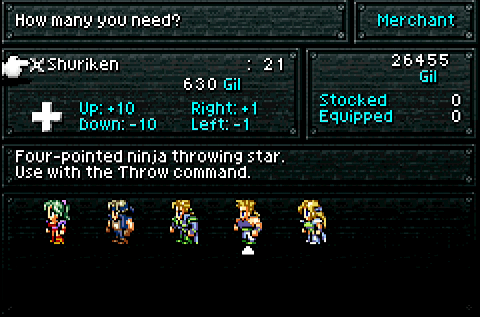
The merchant offers some standard wares, but he also sells a few new items whose value isn’t immediately apparent: Shuriken and scrolls. No one can equip these, but the other part of this little puzzle is standing immediately to your left:
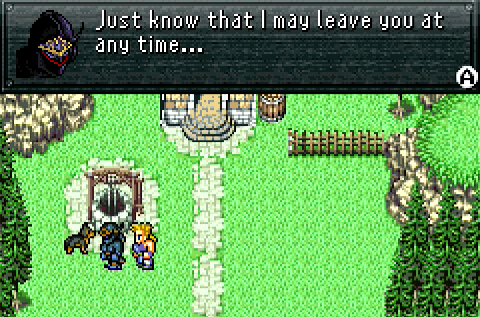
Shadow. Despite his dark reputation, he seems a fairly affable fellow. He’s just hangin’ out in front of some crazy old dude’s house, offering advice to passing martial artists and even offering to tag along. How convenient, and equally handy that there just happened to be a merchant here ready to sell you consumables for Shadow’s special skill. In fact, this entire scenario relies heavily on narrative convenience, coincidence, and downright implausibility.
Shadow isn’t a permanent party member at this point; as he warns, he can potentially leave the party at (almost) any time, bugging off at the end of a battle and leaving Sabin solo. That’s only happened to me once in all the times I’ve played FFVI, though. Normally, he sticks around until the fixed point in the story at which he goes his own way no matter what.
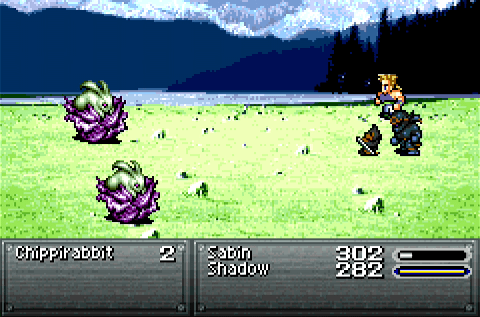
Shadow doesn’t travel alone, and his dog Interceptor wasn’t given his name by coincidence. Besides whatever statistical chance Shadow has of evading enemy attacks, there’s also a pretty strong chance (even odds, based on my experience) that Interceptor will leap in to parry any physical attack that targets Shadow, all but nulling the damage. Not only that, but from time to time Interceptor will follow one of these parries with a counter, dashing into the battlefield to deliver an insanely powerful strike in response to the attacker. While there are some limitations to Interceptor’s aid — there’s a chunk of the middle game where Shadow travels solo and doesn’t benefit from Interceptor’s help, and you can lose the dog forever due to a weird status-swapping glitch late in the game — this added defensive element makes Shadow an incredibly valuable party member.
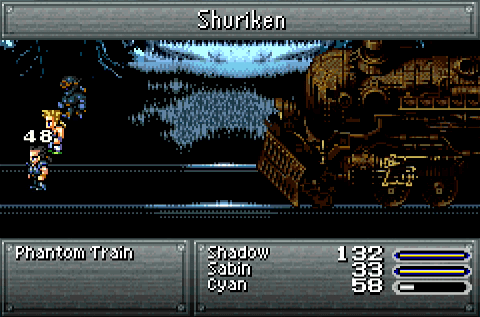
However, that’s not Shadow’s real special technique. Interceptor’s just a bonus! No, his unique secondary command is Throw, which works exactly as it did for Ninja characters in previous Final Fantasy games: Shadow is able to throw any edged weapon at an enemy for considerably greater damage than it would inflict when used for a standard attack. The downside, however, is that once you toss a weapon, it’s gone forever. So while you could theoretically chuck a one-of-a-kind sword like the Atma Weapon at a foe, that would be deeply foolish.
Luckily for Shadow’s utility, you can buy relatively inexpensive consumables like Shuriken to use with the Throw command. They don’t hit as hard as high-level weapons, but they do the job regardless… and won’t break the bank.
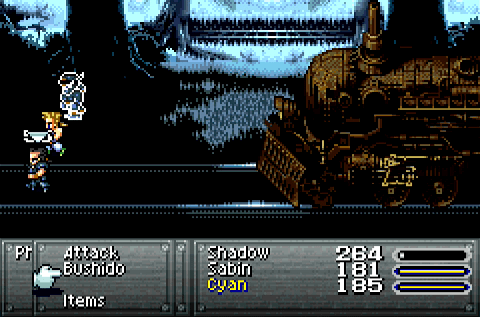
Shadow can also “throw” scrolls, which work as special ninja techniques. An invisibility scroll, for example, causes Shadow to become invisible, making him ineligible for enemy AI to target with single-target attacks.
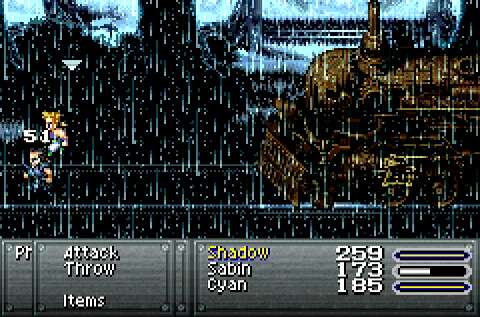
However, group effects and multi-target magic will still hit him, bringing his invisibility status to an abrupt end.
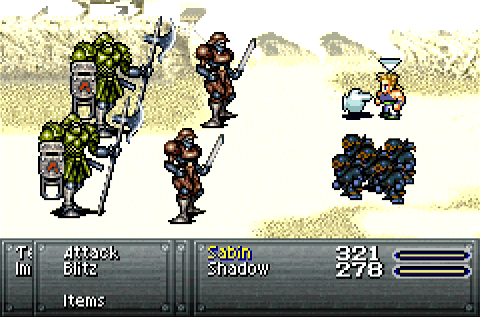
He can also use a Shadow Scroll, which basically works like the spell Blink: It creates an illusionary image that confuses enemies.
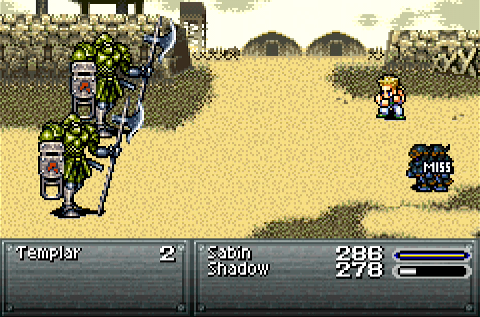
While they can target him, they can’t land a hit. However, his “blink” state wears off after evading a couple of attacks.
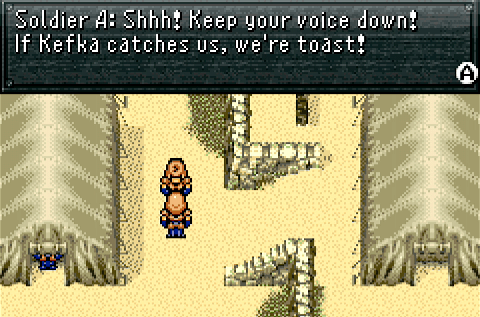
Shadow suggested to Sabin that the only way forward was to traipse through a haunted forest, but this is a video game, and that means there are always obstacles to deal with before you reach the other obstacle before your main objective. In this case, the Imperial Army has set up camp en route in order to stage an assault against the castled town of Doma.
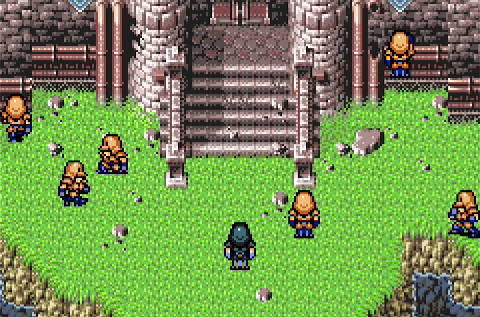
It’s not a very effective assault, as it consists of a handful of soldiers ramming the wall, trying to climb it, and comically failing. Still, the Empire has been remarkably industrious of late: Besides their small assault on Narshe, they’ve also conquered South Figaro and now are making a move on this kingdom.
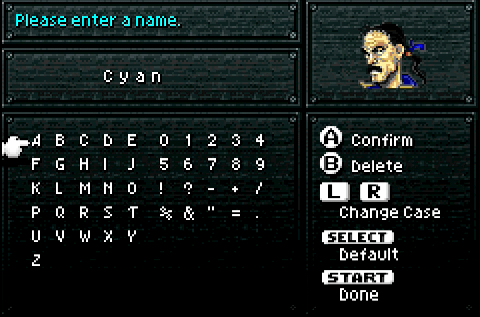
More importantly, though, the cut to Doma reveals that Sabin’s going to have another hungry mouth to feed soon. His name is Cyan, but you can call him “Obi-wan.”
Shadow can and will leave your party at random (I’ve had him do it at this point in the game), but I’m pretty sure his random chances of bailing are temporarily deactivated during the Imperial Camp sequence and when you’re on the Phantom Train because of their “special circumstances”.
I would’ve spoilered those, but they’re right up in the screenshots above so what the hey?
Bingo. There’s one more safe zone later in the game, as well, before he permanently joins. Odds are 1/16 after every fight, which seems awfully high for something that, like the write-up says, doesn’t seem to happen very often! It seems the key is to stay off the overworld.
He’ll also stay in your party if he’s unconscious. I can’t help but laugh at the idea of Sabin clubbing him over the head Final Fantasy II style and dragging him from place to place.
I love Shadow. His style, his dog, his hidden story elements… but most of all his music, which is the most lovely piece of that brilliant soundtrack.
My friends and I always renamed Cyan to “Sturm” after the stuck-up knight from the Dragonlance books. We was nerdy.
I’m pretty sure I did that at least once too.
I always name around a theme. Last time everybody was named after an actor who played Batman. (Cyan was Conroy because he’s got the whole tragic knight thing going on. I think Sabin and Shadow were Kilmer and Keaton.)
That is…pretty damned nerdy. I say that as someone who knows for a fact that the naming blank is one letter too short for the name “Aragorn”, forcing one to go with AraGON, in case one were inclined to rename Edgar in the midst of discovering the Lord of the Rings books right around the time you were playing Final Fantasy 6.
Not that I was, mind you. You’re the nerd here, not me.
Can we talk about how great Triple Triad is for a minute?
Because it is so great.
This might have been my favourite section of the entire game, somewhat weirdly I suppose. Specifically, Locke’s adventures in South Figaro were just the best, in spite of the fact I didn’t much care for Locke as a character, even playing the game as a thirteen year old originally. But the splitting of the parties was something I don’t think I had ever encountered before in a game. and the story beats were pretty damned remarkable for a game of this vintage, at least in the console RPG world of the time.
One minor correction: I think it was Osmose that actually allowed you to recover your own MP by draining it from the enemy, if I remember correctly. Rasp just did MP damage to the enemy, I think. (It’s been several years since I went back and played this, when it was first added to Virtual Console, so I could be wrong.)
Really enjoying the series, Mr. Parish. FF6 might still be my favourite game of all time, and I’m having a great time going through it beat by beat with you.
Ah, you’re right about Osmose. I haven’t made it that far into the game yet, so I’d forgotten the distinction.